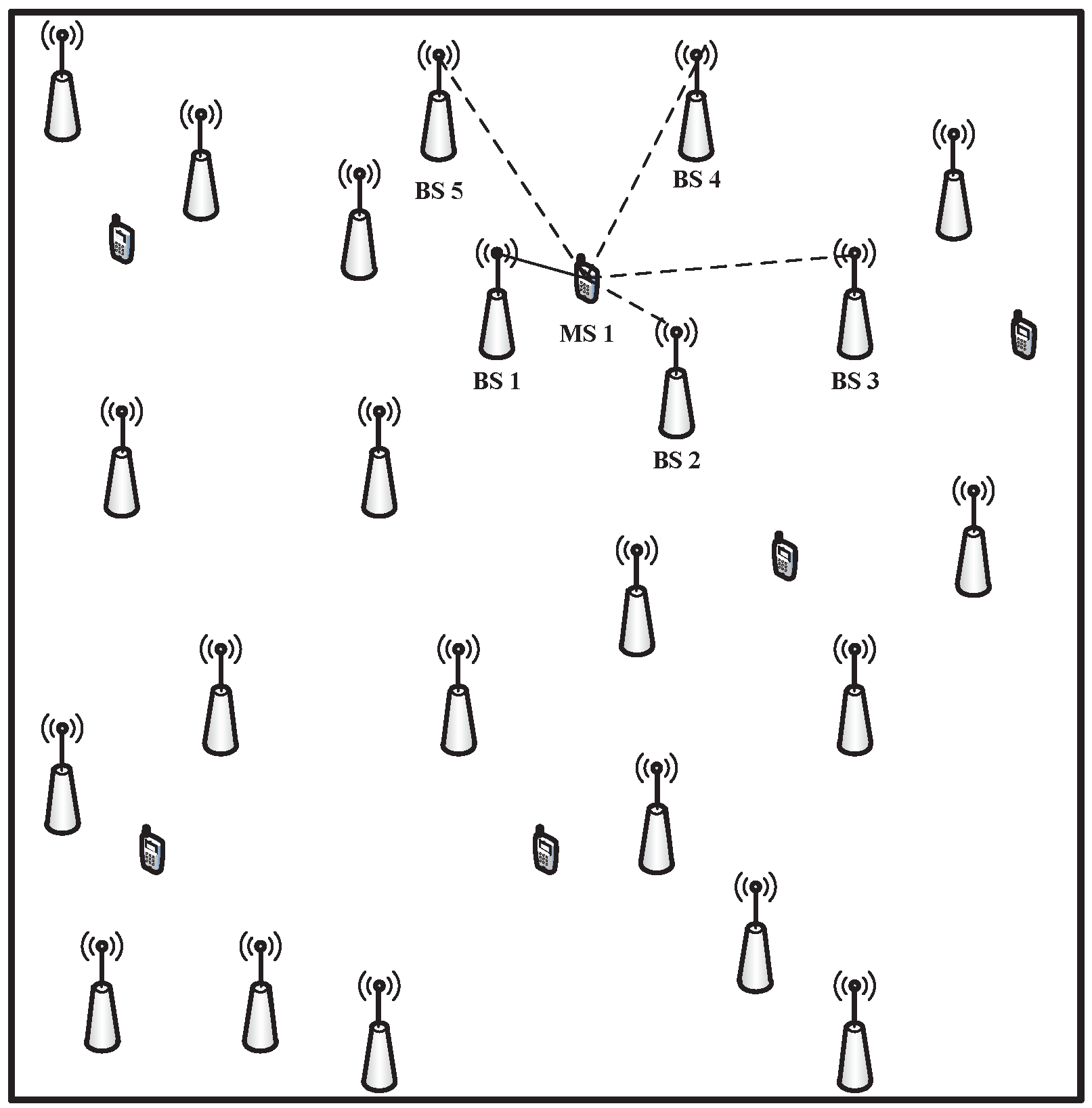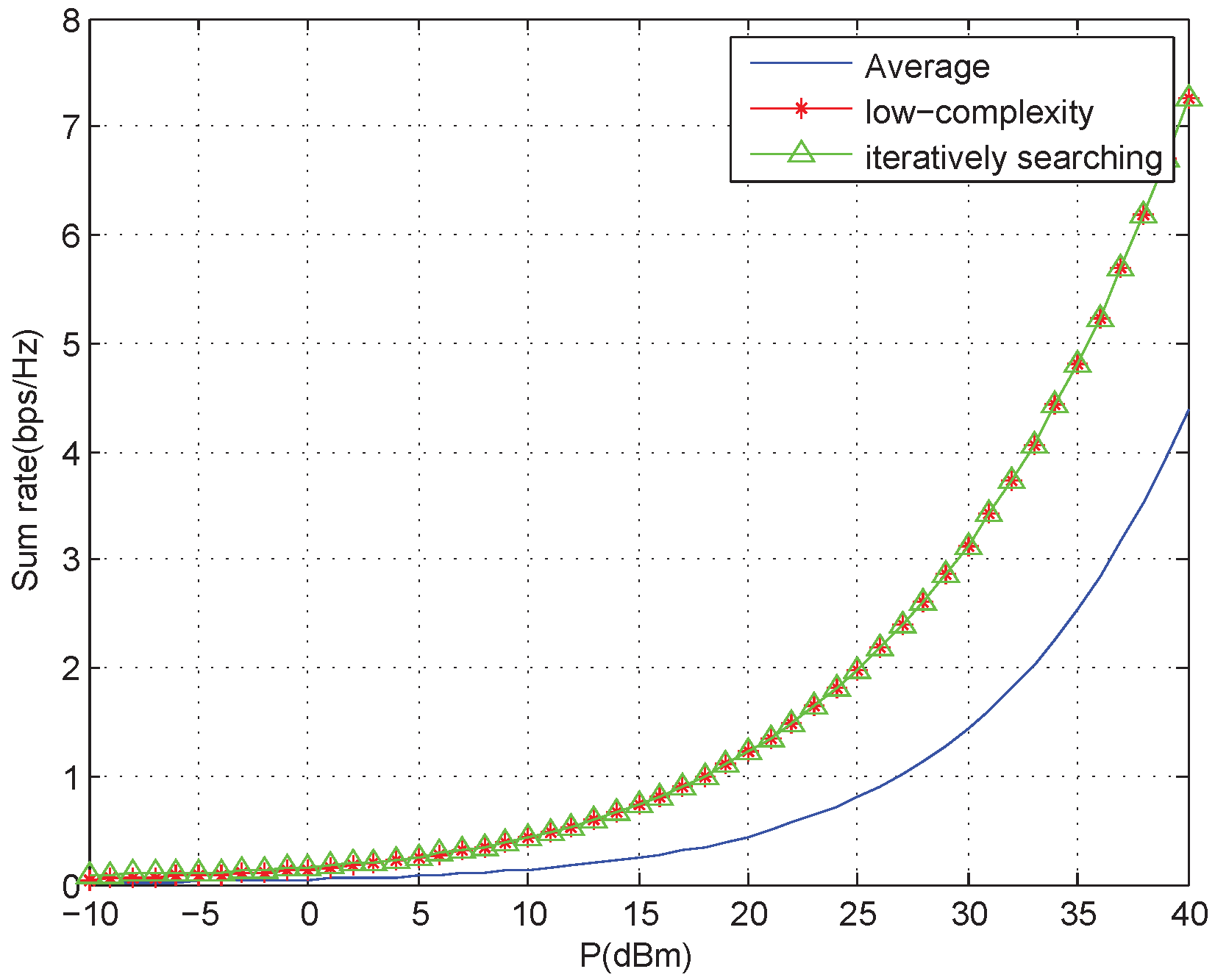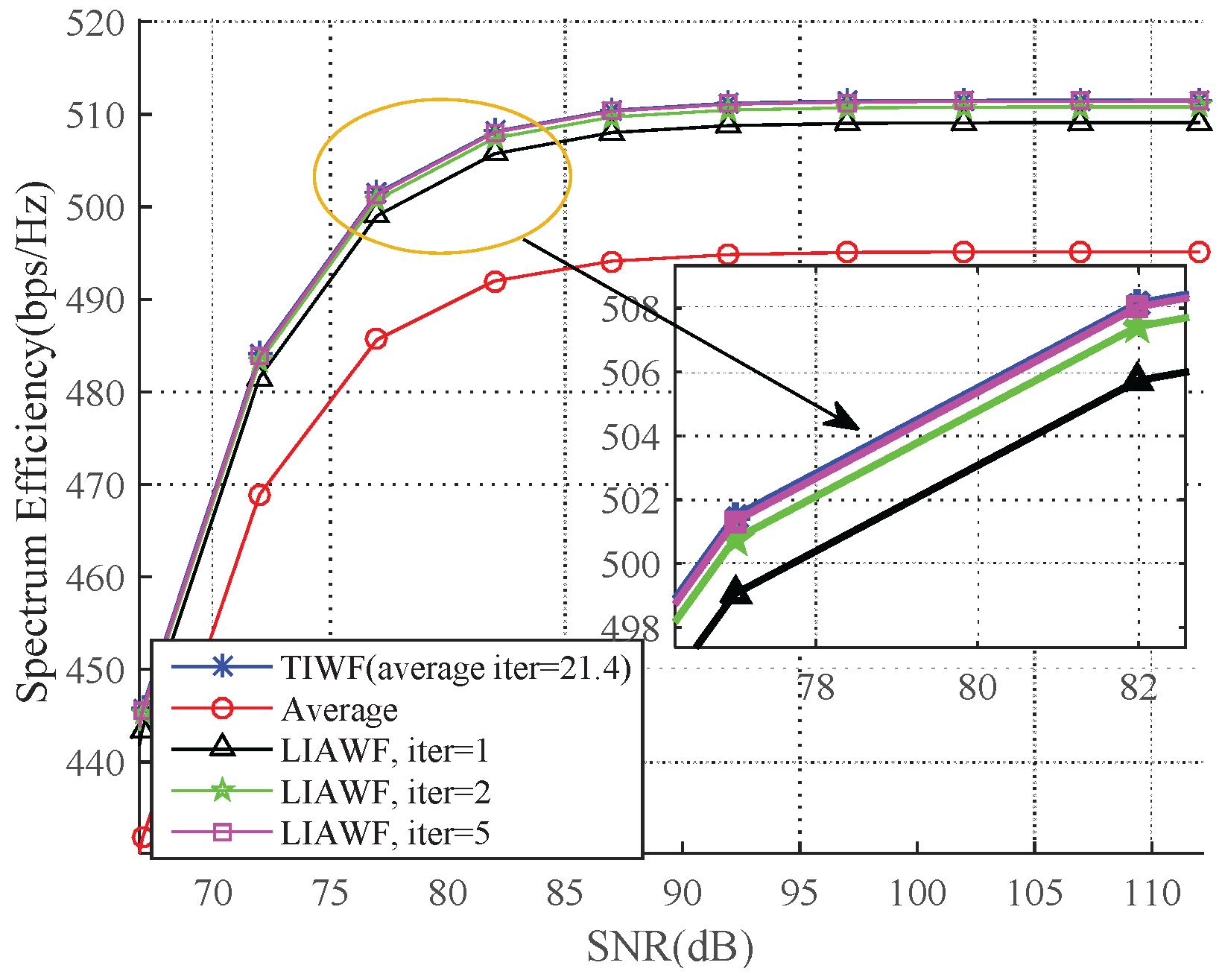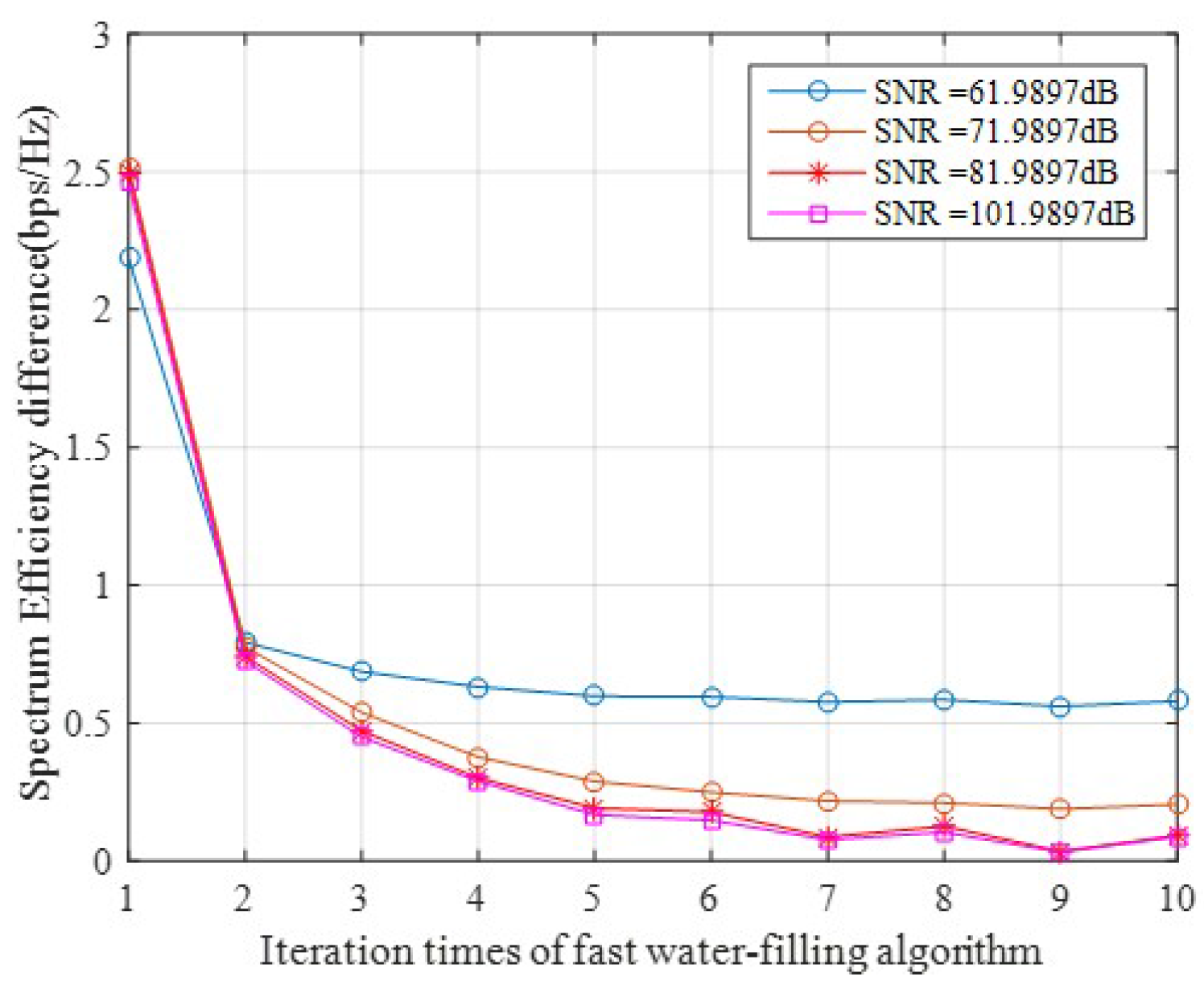Low-Complexity Iterative Approximated Water-Filling Based Power Allocation in an Ultra-Dense Network
Abstract
:1. Introduction
- We derive the optimum power allocation in the UDN region with the limitation of total power by the Lagrangian Multiplier method, and the water filling based power allocation can be applied to maximum the area capacity and the SE.
- Since the traditional iteratively searching water filling needs many iterations, we developed the LIAWF algorithm to reduce the complexity without performance degradation. The proposed LIAWF can achieve the very close performance as the traditional iteratively searching water filling algorithm.
2. Downlink BS Transmitting Power Allocation
2.1. Signal Model and Problem Formulation
2.2. LIAWF Based Power Allocation
2.2.1. Iteratively Searching Water Filling Algorithm
2.2.2. LIAWF Based Power Allocation
3. Joint Subcarrier Power Allocation
3.1. Signal Model
3.2. LIAWF Based Power Allocation
4. Simulation Results
5. Discussion
6. Conclusions
Acknowledgments
Author Contributions
Conflicts of Interest
References
- Bhushan, N.; Li, J.; Malladi, D.; Gilmore, R.; Brenner, D.; Damnjanovic, A.; Sukhavasi, R.; Patel, C.; Gerihofer, S. Network Densification: The Dominant Theme for Wireless Evolution into 5G. IEEE Commun. Mag. 2014, 52, 82–89. [Google Scholar] [CrossRef]
- Gelabert, X.; Legg, P.; Qvarfordt, C. Small Cell Densification Requirements in High Capacity Future Cellular Netwoks. In Proceedings of the 2013 IEEE International Conference on Communications Workshops (ICC), Budapest, Hungary, 9–13 June 2013; pp. 1112–1116.
- Sui, Y.; Guvenct, I.; Svensson, T. On the Deployment of Moving Networks In Ultra-dense Urban Scenarios. In Proceedings of the IEEE International Conference on 5G for Ubiquitous Connectivity (5GU), Akaslompolo, Finland, 26–28 November 2014; pp. 240–245.
- Lopez-Perez, D.; Ding, M.; Claussen, H.; Jafari, A.H. Towards 1 Gbps/UE in Cellular Systems: Understanding Ultra-Dense Small Cell Deployments. IEEE Commun. Surv. Tutor. 2015, 17, 2078–2101. [Google Scholar] [CrossRef]
- Chuang, M.-C.; Chen, M.C.; Sun, Y.S. Resource Management Issues in 5G Ultra Dense Small cell Networks. In Proceedings of the IEEE International Conference on Information Networking (ICOIN), Siem Reap, Cambodia, 12–14 January 2015; pp. 159–164.
- Li, Y.-N.R.; Li, J.; Wu, H.; Zhang, W. Energy Efficient Small Cell Operation under Ultra Dense Cloud Radio Access Networks. In Proceedings of the IEEE Globecom Workshops, Austin, TX, USA, 8–12 December 2014; pp. 1120–1125.
- Ren, Q.; Fan, J.; Luo, X.; Xu, Z.; Chen, Y. Analysis of Spectral and Energy Efficiency in Ultra-Dense Network. In Proceedings of the Communication Workshop (ICCW), London, UK, 8–12 June 2015; pp. 2812–2817.
- Qian, L.; Wu, G.; Hu, Q. Analytical Study on Network Spectrum Efficiency of Ultra Dense Networks. In Proceedings of the IEEE International Sysmposium Personal Indoor and Mobile Radio Communications, London, UK, 8–9 September 2013; pp. 2764–2768.
- Olsson, M.; Cavdar, C.; Frenger, P.; Tombaz, S.; Sabella, D.; Jantti, R. 5GrEEn: Towards Green 5G mobile networks. In Proceedings of the 2013 IEEE 9th International Conference on Wireless and Mobile Computing, Networking and Communications (WiMob), Lyon, France, 7–9 October 2013; pp. 212–216.
- Xiao, X.; Tao, X.; Jia, Y.; Lu, J. An Energy-Efficient Hybrid Structure with Resource Allocation in OFDMA Networks. In Proceedings of the IEEE Wireless Communications and Networking Conference (WCNC), Cancun, Mexico, 28–31 March 2011; pp. 1466–1470.
- Zhou, Z.; Dong, M.; Chang, Z. Energy-Efficient Context-Aware Matching for Resource Allocation in Ultra-Dense Small Cells. IEEE Access 2015, 3, 1849–1860. [Google Scholar] [CrossRef]
- Koudourdis, G.P. On the Capacity and Energy Efficiency of Network Scheduling in Future Ultra-Dense Networks. In Proceedings of the IEEE Symposium Computers and Communicatin (ISCC), Madeira, Portugal, 23–26 June 2014.
- Dudnikova, A.; Dini, P.; Giupponi, L.; Panno, D. Multi-Criteria Decision for Small Cell Switch off in Ultra Dense LTE Networks. In Proceedings of the 2015 13th International Conference on Telecommunications (ConTEL), Graz, Austria, 13–15 July 2015.
- Claussen, H.; Ashraf, I.; Ho, L.T.W. Dynamic Idle Mode Procedures for Femtocells. Bell Labs Tech. J. 2010, 15, 95–116. [Google Scholar] [CrossRef]
- Cheng, L.; Gao, Y.; Li, Y.; Yang, D.; Liu, X. A Cooperative Resource Allocation Scheme Based on Self-Organized Network in Ultra-Dense Small Cell Deployment. In Proceedings of the 2015 IEEE 81st Vehicular Technology Conference (VTC Spring), Glasgow, UK, 11–14 May 2015.
- Liu, L.; Garcia, V.; Tian, L.; Pan, Z.; Shi, J. Jonit Clustering and Inter-cell Resource Allocation for CoMP in Ultra Dense Cellular Networks. In Proceedings of the 2015 IEEE International Conference on Communications (ICC), London, UK, 8–12 June 2015.
- Jang, J.; Lee, K.B.; Lee, Y.H. Transmit Power and Bit Allocations for OFDM Systems in a Fading Channel. In Proceedings of the IEEE Global Communications Conference, San Francisco, CA, USA, 1–5 December 2003; pp. 283–288.
- Peng, T.; Wang, W.; Lu, Q.; Wang, W. Subcarrier Allocation Based on Water-filling Level in OFDMA-based Cognitive Radio Networks. In Proceedings of the IEEE Wireless Communications, Networking and Mobile Computing, Shanghai, China, 21–25 September 2007; pp. 196–199.
- Feng, Z.; Wei, Z.; Shuai, T.; Zhang, Q.; Li, R. An Iterative Water-fillin Based Resource Allocation Scheme in OFDMA Systems for Energy Efficiency Optimization. In Proceedings of the IEEE VTC Fall, Quebec City, QC, Canada, 24–28 September 2012; pp. 1–5.
- Gao, L.; Cheng, X.; Zhang, Y.; Zhu, Y.; Zhang, Y. Enhanced Power Allocation Scheme in Ultra-Dense Small Cell Network. China Commun. 2016, 13, 21–29. [Google Scholar]
- Kim, J.; Lee, H.-W.; Chong, S. Virtual Cell Beamforming in Cooperative Networks. IEEE J. Sel. Areas Commun. 2014, 32, 1126–1138. [Google Scholar] [CrossRef]
- Shannon, C.E. A Mathematical Theory of Communication. Bell System Tech. J. 1948, 27, 379–423, 623–656. [Google Scholar] [CrossRef]
- Goldsmith, A. Wireless Communication; Cambridge University Press: Cambridge, UK, 2005. [Google Scholar]
- Yunas, S.F.; Valkama, M.; Niemela, J. Spectral and Energy Efficiency of Ultra-Dense Networks under Different Deployment Strategies. IEEE. Mag. 2015, 53, 90–100. [Google Scholar] [CrossRef]
- 3GPP TR 36.814. Further Advancements for E-UTRA Physical Layer Aspects (Release 9). Available online: http://wenku.baidu.com/view/17b6456e7e21af45b307a8fd.html (accessed on 21 April 2016).
- Zhang, H.; Jiang, C.; Beaulieu, N.C.; Chu, X.; Wang, X.; Quek, T.Q.S. Resource Allocation for Cognitive Small Cell Networks: A Cooperative Bargaining Game Theoretic Approach. IEEE Trans. Wirel. Commun. 2015, 14, 3481–3493. [Google Scholar] [CrossRef]




© 2016 by the authors; licensee MDPI, Basel, Switzerland. This article is an open access article distributed under the terms and conditions of the Creative Commons Attribution (CC-BY) license (http://creativecommons.org/licenses/by/4.0/).
Share and Cite
Su, X.; Liu, B.; Zhu, X.; Zeng, J.; Xiao, C. Low-Complexity Iterative Approximated Water-Filling Based Power Allocation in an Ultra-Dense Network. Entropy 2016, 18, 158. https://doi.org/10.3390/e18050158
Su X, Liu B, Zhu X, Zeng J, Xiao C. Low-Complexity Iterative Approximated Water-Filling Based Power Allocation in an Ultra-Dense Network. Entropy. 2016; 18(5):158. https://doi.org/10.3390/e18050158
Chicago/Turabian StyleSu, Xin, Bei Liu, Xiaopeng Zhu, Jie Zeng, and Chiyang Xiao. 2016. "Low-Complexity Iterative Approximated Water-Filling Based Power Allocation in an Ultra-Dense Network" Entropy 18, no. 5: 158. https://doi.org/10.3390/e18050158
APA StyleSu, X., Liu, B., Zhu, X., Zeng, J., & Xiao, C. (2016). Low-Complexity Iterative Approximated Water-Filling Based Power Allocation in an Ultra-Dense Network. Entropy, 18(5), 158. https://doi.org/10.3390/e18050158




